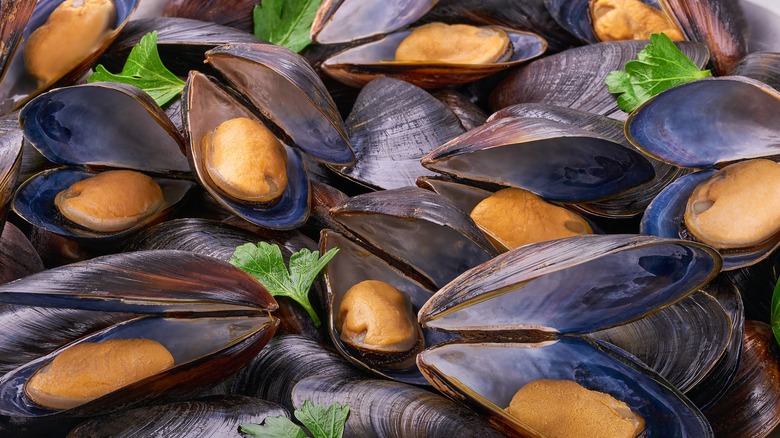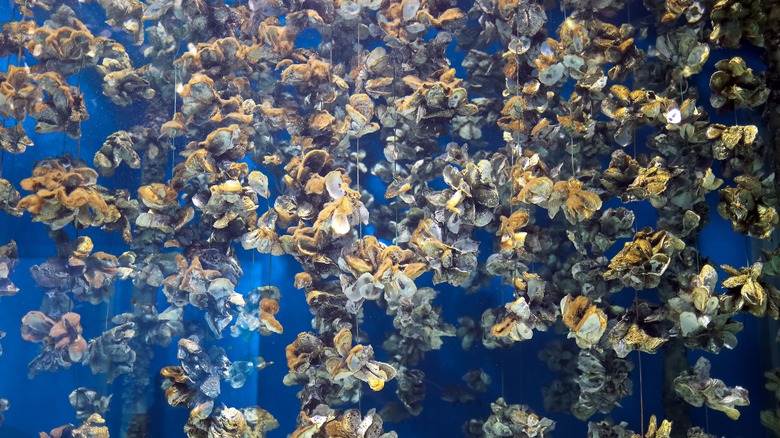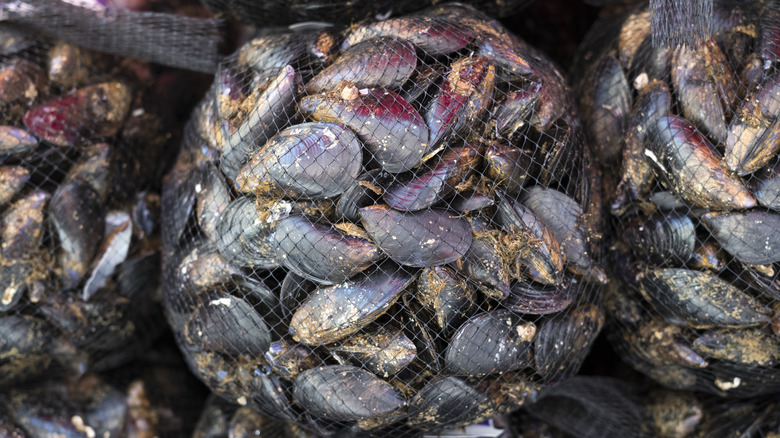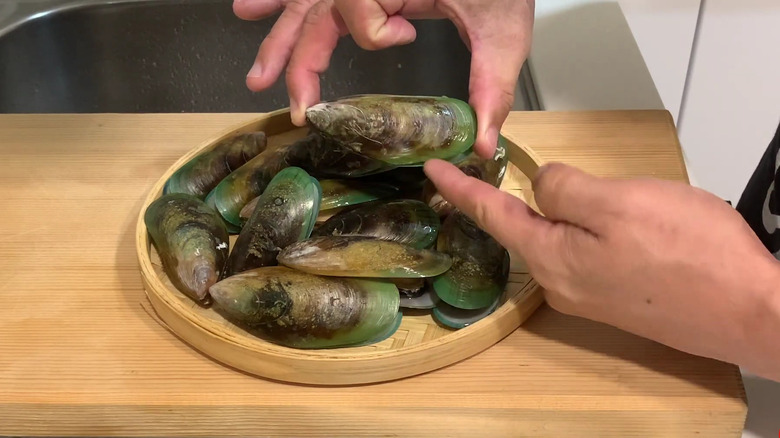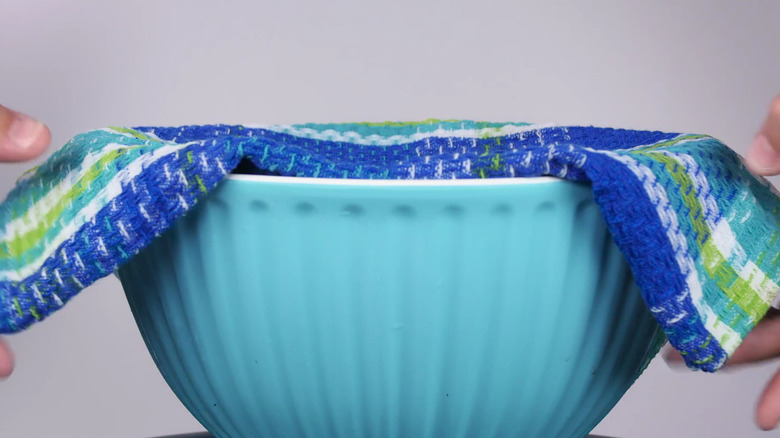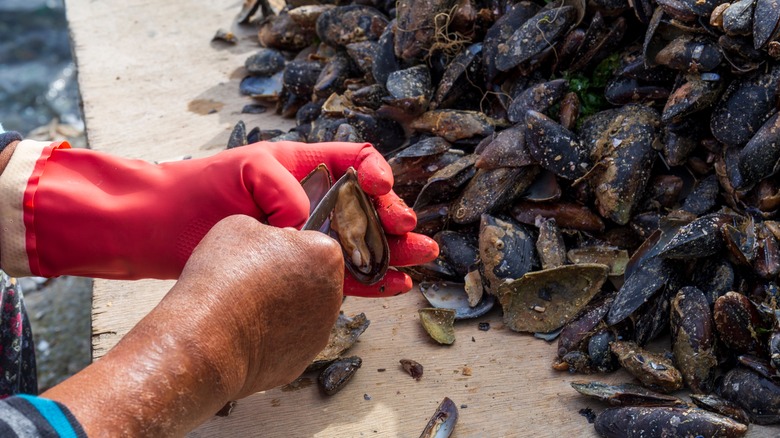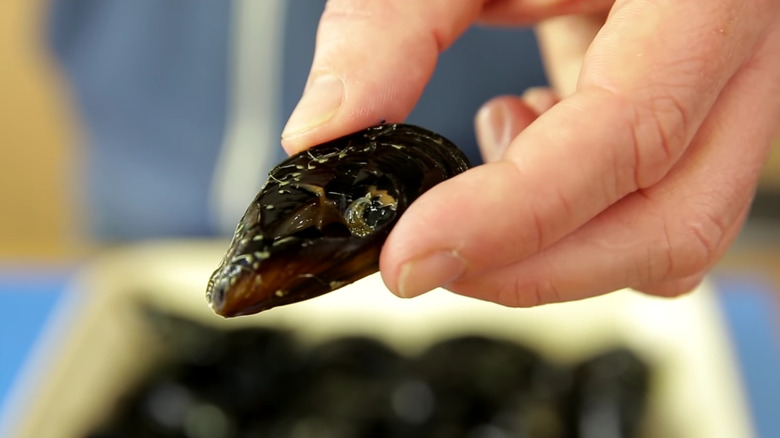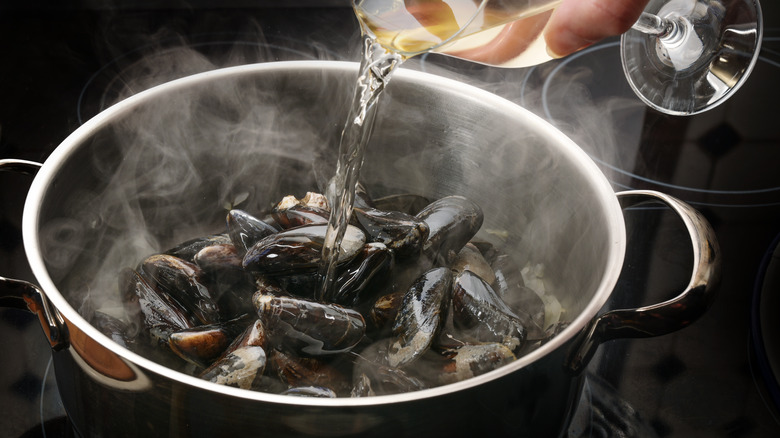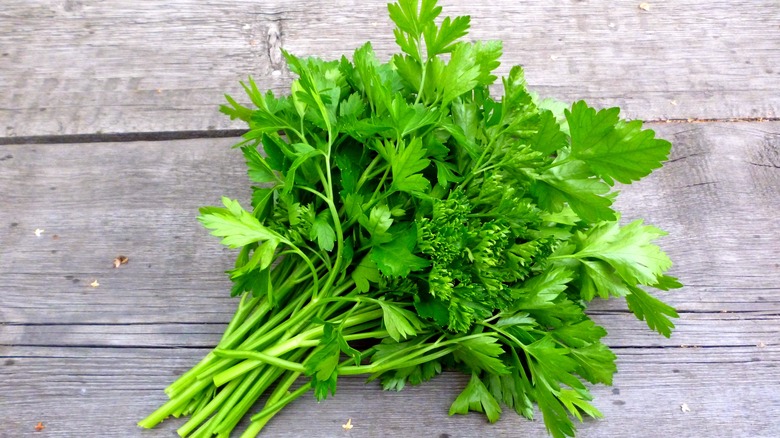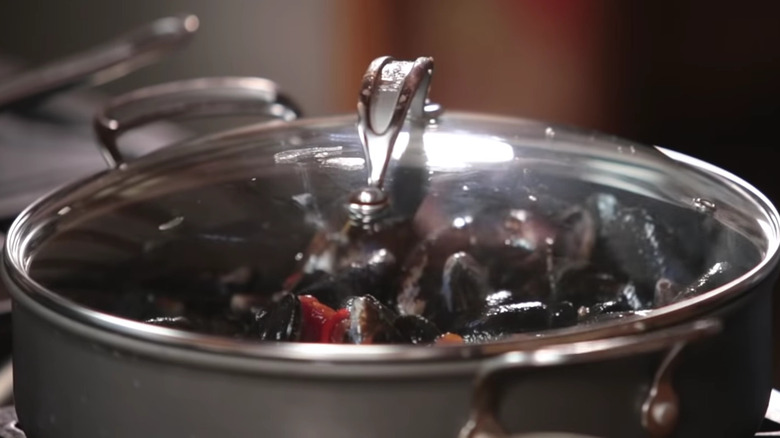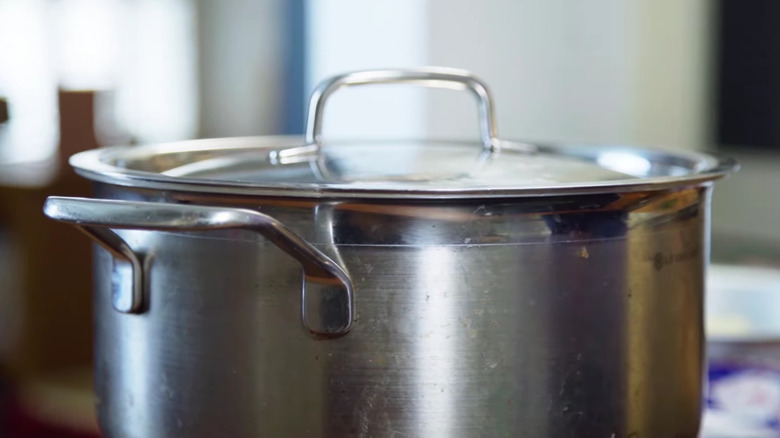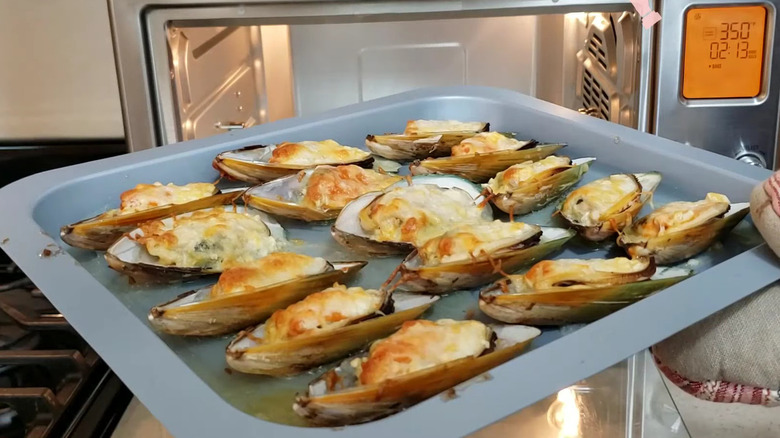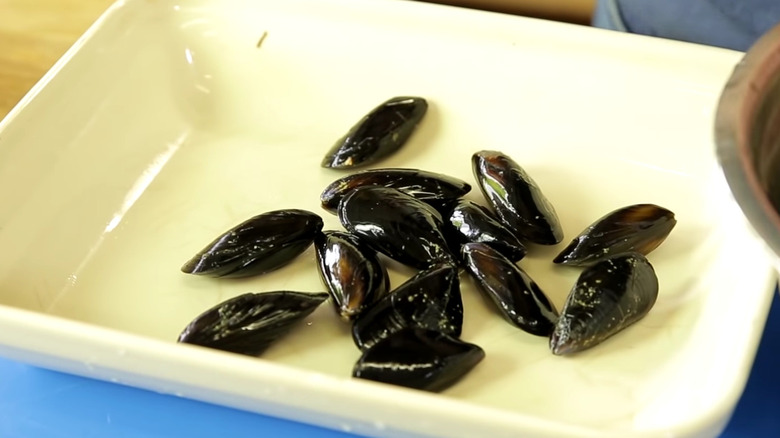13 Mistakes You're Making When Cooking Mussels
As bivalves go, mussels are underrated. They do not receive the acclaim that clams do. Nor are they associated with luxury as oysters are. Yet, mussels have been an incredibly important food source for some 20,000 years. Today, they are known for their agreeable flavor, low price point, and nutritional profile.
The one aspect that sets mussels apart from other forms of animal protein is their sustainability. As the world struggles to feed its ever-growing population, this sustainability indicates that the mussels' moment in the spotlight is imminent.
According to author and fisherman Paul Greenberg, since meats like beef pose a tremendous challenge to the planet in terms of resources, it's unlikely that we'll get to a place where everyone can consume beef. However, he does believe this is possible for mussels (via NPR).
This being said, many potential consumers are put off cooking mussels because they seem like a complicated or even risky ingredient. In an effort to allay these fears, it's best to familiarize yourself with some common mistakes that people make when cooking mussels. You'll soon see that mussels aren't nearly as complex as they first seem.
1. Choosing wild over farmed mussels
It's a common assumption that wild is superior to farmed when it comes to all types of produce. While this may be the case for some seafood, the opposite is true for mussels for a variety of reasons.
Firstly, mussel farms create an environment in which other marine species thrive. Andrew Airnes, director at the Isle of Skye Mussel Company, highlighted this to The Guardian and noted that mussel farming actually creates a marine ecosystem. Rotating the ropes increases biodiversity by 1.6 times and biomass by 3.6 times.
What's more, the bivalves can help restore the surrounding water's purity as they filter up to 25 liters of water per day. Mmussels, as filter feeders, require no inputs, meaning farming them is both cheap and environmentally sound.
Another benefit of farming mussels is that doing so boosts wild mussel populations. This is because the farmed mussels release spat (juvenile mussels) into the open water. From a consumer perspective, farmed mussels are also safer. The water around mussel farms is diligently checked, ensuring that humans do not ingest mussels full of harmful toxins. This can be the case with wild mussels harvested from near sewers, toxic algae blooms, or factories.
2. Not checking your mussels for freshness
As the flesh decays rapidly, consuming mussels that are not fresh can lead to various illnesses (as per Livestrong). As such, purchasing mussels that are still alive is vitally important. Thankfully, it is quite easy to distinguish between fresh mussels, live mussels, and dead ones.
First of all, the mussels should either be closed, or they should be closed after being tapped. Any mussels that stay open after tapping or squeezing are dead and should not be purchased or cooked (via Fine Dining Lovers).
The smell is another indicator of freshness; the mussels should not smell overly fishy. Instead, they should smell like the sea. According to chef Louis Tikaram, mussels should smell like diving through a wave. If they smell like the ocean, then they're good to eat (via GQ Magazine).
If you're in doubt about mussels' freshness ask your fishmonger when they were caught. Most can live for about four days after being harvested. Any longer, and they should definitely be avoided.
3. Buying frozen mussels
Frozen mussels are nowhere near as good as their fresh counterparts, for reasons chef Matt Wynn describes: The mussels tend to lose too much flavor when frozen. If you're using frozen mussels, the sauce must be pretty good, but even if the sauce is good, the mussels are likely to taste rubbery and have an unpleasant texture (via Food & Wine).
It's not just flavor that mussels lose through freezing, but nutrients as well. A study published in The Journal of Food Science and Technology found that freezing mussels caused levels of polyunsaturated and monounsaturated fats (the so-called good fats) to drop. The level of minerals also plummeted. On the other hand, the amount of unhealthy saturated fats increased. In other words, mussels are significantly less healthy when frozen as opposed to fresh.
If you must buy frozen mussels, The Food and Drug Administration advises against packets that have frost in them. This may be a sign the shellfish was allowed to defrost at one time, potentially making the mussels unfit for consumption.
4. Storing live mussels incorrectly
Ideally, mussels, like all shellfish, should be consumed as soon as they are purchased, but this is not always possible. So, learning to store them correctly is crucial. After all, there is little point in buying fresh mussels if you accidentally kill them as soon as you get home.
Pretty much all mussels consumed by humans today are marine animals. Because of this, submerging mussels in freshwater will drown them. Equally, sealed containers or plastic bags should always be avoided; the mussels should be able to breathe.
Mussels must be kept cool and wet in order to survive. As such, they are best kept in the fridge. The perfect way to store them is in a container covered with a damp tea towel. This keeps the mussels moist. Be sure to drain your container now and again, as the mussels may excrete water. Covering the mussels with ice is another way to keep them fresh in the fridge. It is important that you drain them in a container. Otherwise, the melting ice will drown them.
5. Not cleaning them thoroughly enough
Before you begin cooking the mussels, it is important to give them a good clean. How much cleaning they require will depend on where they were harvested from. Mussels farmed on ropes are generally cleaner. Grit has minimal opportunities to seep into these shells. On the other hand, wild mussels plucked from near the sea bed usually require purging to rid the flesh of sand. Generally, if you buy your fresh mussels from a fishmonger or store, they will have already been purged.
Purged mussels should be scrubbed under running water with a stiff brush to remove any exterior dirt. Barnacles can be removed with a blunt knife. Mussels also need to have their byssal threads, known as beards, removed before cooking. This involves pulling the thread-like material towards the hinge of the shell. It should snap and pull away at this point. Do not pull it the other way, as this may damage the flesh of the mussels.
6. Cooking open or damaged mussels
If the mussels open at any point before cooking and do not close when tapped or squeezed, they have died prematurely. Mussels that have died before being cooked should always be discarded. Failure to do so significantly increases your chances of suffering from various types of food poisoning (as per Livestrong). Mussels with broken shells should also be discarded. These have likely been damaged in transit and are probably dead as well.
Unfortunately, shell breakage is a consistent problem for everyone in the mussel supply chain. According to Fish Farmer, approximately 2 percent of all mussels harvested in Scotland are discarded due to damaged shells. Scientists are looking for means of reducing shell breakage at all stages of the supply chain in order to limit waste.
According to Heather Jones, CEO of the Sustainable Aquaculture Innovation Centre, shell breakage is an issue, and tools that can help monitor the growth of mussels are essential. She notes that organizations interested in shellfish can collaborate regarding these methods.
Unfortunately, there is no way of similarly reducing the number of mussels wasted through incorrect storage. Education is the only means of tackling this type of needless waste.
7. Cooking them for too long
When cooked properly, mussels are soft, succulent, and incredibly flavorful. However, it is incredibly easy to overcook mussels due to their small size. Overcooking causes mussels to shrivel up, lose their flavor, and develop an unpleasant, tough texture.
Mussels only require a few minutes of steaming to cook sufficently. It is easy to tell when they are done; their shells will open. This occurs because the muscle which holds the shell closed usually breaks during the cooking process. It's very important to cook the mussels for just a couple of minutes and then immediately take them off the heat.
As Louis Tikaram told GQ MAgazine, cooking mussels should not intimidate any chef. All they need is a gentle heat to open up. Once you think they're cooked, they're already overdone. It's best to just cook them quickly and then take them off the heat and let them continue to cook in the pan.
8. Using poor quality wine
A popular recipe for mussels is the French dish moules marinières. In this recipe, steam is used to cook the mussels as opposed to water. This adds a pleasant sharpness and minerality to the dish when done correctly. However, many home cooks are in the habit of reaching for the cheapest wine possible when cooking. This is a bad decision. A poor-quality wine will make food taste bad. This is especially true for recipes like moules marinières, in which the wine is only cooked for a few short minutes.
Of course, poor quality doesn't necessarily mean cheap. Even expensive wines can be bad, especially if they have been sitting open in the fridge for a week or if they have become corked. Acclaimed chef José Pizarro explained the approach he takes to selecting cooking wines to The Guardian. He suggests cooking with good-quality wine or sherry. Buying a cheap bottle will affect the taste of the final dish. It's also essential not to use corked wine.
9. Forgetting aromatics
Many mussel recipes, like the aforementioned moules marinières, are extremely simple. Usually, they are made up of a handful of ingredients selected to amplify the taste of the bivalve. Aromatics are a chef's biggest friend in this regard.
Vegetables like onions and celery, as well as herbs including parsley, all help to elevate the delicate flavor of the mussels without becoming overbearing. Michelin star chef Nicola Fanetti also uses them for the smell they impart, as she likes the flavors of herbs like rosemary, thyme, oregano, and sage (via Luxurious Magazine).
Using aromatics is a surefire way to supercharge your mussel dish. The most obvious choice is parsley, the peppery taste of which balances seafood out perfectly. While parsley is best added as a garnish, sauteing vegetables like celery, onions, and garlic before you steam them adds extra flavor to the dish. This also has the happy effect of flavoring the broth that arises during steaming. This can either be eaten as part of the meal or saved as stock.
10. Boiling instead of steaming
While cooking mussels in liquid, it is not advisable to submerge and boil them. This is because mussels cooked via this method will not open. The traditional method of steaming mussels is much preferable as steamed mussels open of their own accord. Not only does steaming make the process of eating mussels easier, it is also a more delicate means of cooking. The lack of direct heat, and the moist atmosphere the mussels cook in, should prevent the flesh from drying out.
Specialist equipment, like bamboo steamers, can be used to steam the mussels. However, most cooks simply rely on a pot that has a tight-fitting lid. Any liquid can create the steam necessary. Stock, water, and wine are favorites, thanks to the classic flavors they impart. The more adventurous can opt for chopped tomatoes, beer, or even spirits to add an extra twist to their dish.
11. Not using a lid
When steaming mussels, it is vital that a tight-fitting lid is used. This should be left on throughout the steaming process and only fully removed once the mussels are sufficiently cooked. This is because the lid traps the steam in the pot. Removing it would see some steam escape and the cooking temperature drop, prolonging the cooking process. There should also be plenty of space in the pot, this will allow the steam to circulate, ensuring the mussels are evenly cooked.
Interestingly, steaming with a lid on also helps ethanol cook off faster. An important piece of information if you are steaming your mussels in alcohol such as white wine. Dr. Kim-Yen Phan-Thien reported this phenomenon to SBS and noted that if the pots have a lid for broths, that would also increase the evaporation.
This will lead to less ethanol in the pan when you cook with alcohol in a pot that has a lid rather than a pot that doesn't. This should help prevent quick-cooked recipes, like moules marinières, from being dominated by the taste of alcohol.
12. Thinking that steaming is your only option
While steaming is the classic cooking choice for mussels, it is not the only option. Roasting opens up a whole new world of possibilities for the bivalves, including different ingredient combinations and new textures. Roasting mussels for 10 to 15 minutes at 480 degrees Fahrenheit will allow them to cook sufficiently. As with steaming, you know they are done once the shells have opened and the flesh is firm to touch.
Alternatively, mussels can be sautéed along with other ingredients on the stovetop. According to Chef Oscar Solomon, while everyone enjoys steaming mussels in garlic and white wine, he was influenced by Japanese cooking and cooked them in stock. This approach can be used to make miso soup or pair the mussels with pasta or noodles for an umami sauce.
Multiple cooking processes can even be employed for maximum effect. For example, mussels may be steamed until they open. These shells can then broken in half and the mussel covered in cheese, breadcrumbs, or other toppings. Finally, they can be broiled to attain a crisp texture.
13. Discarding all closed mussels
People have long thought that mussels that remain closed after cooking should be discarded. The idea behind this is that closed mussels were dead before they were cooked and are thus unsafe for consumption. However, some scientists have begun to dispute this, arguing that closed mussels are perfectly safe.
Scientist Nick Ruello told Spring Bay Seafoods that this advice is actually unfounded. Closed mussels must be opened so that they can be checked. These mussels may very well be safe to eat.
The reasons why perfectly fine mussels don't open is down to how their adductor muscles (which keep the shells closed) react to the heat. Sometimes they become damaged in a way that prevents the shell from slipping open.
Of course, some shells might still be firmly closed if the mussel is not sufficiently cooked, but this will become apparent as soon as you open it. Chef Michael Bacash encourages people to use their instinct: If the mussels smell fresh, they can be eaten.
